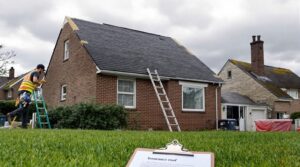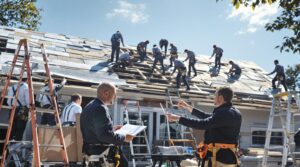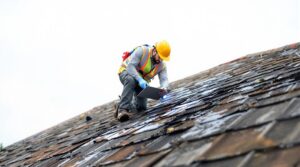Has your insurance company just denied your roof claim? Don't let that "no" be the final word! Think of this situation like a chess game – you've got several strategic moves ahead.
First up, become a documentation warrior. Grab your smartphone and capture every crack, leak, and damaged shingle from multiple angles. You'll want photos so detailed they could win a photography contest – trust me, these will be your golden tickets in the appeal process.
Let's bring in the cavalry: a certified NRCIA roof inspector. These pros are like CSI investigators for your roof, providing an unbiased, professional assessment that insurance companies can't easily dismiss. Their detailed report carries serious weight in the appeals process.
Ready to fight back? Your appeal toolkit should include:
- Fresh inspection reports
- Your roof's maintenance history
- Evidence of the weather event (think news reports, weather data)
- Before-and-after photos
- Neighbor testimonials
Here's a game-changer: consider partnering with a public adjuster. These claims wizards typically secure settlements 5-6 times higher than DIY attempts. They speak the insurance language and know every trick in the book to get you fair compensation.
Remember, a denied claim isn't a dead end – it's just your first round. With the right evidence and expertise in your corner, you've got multiple paths to turn that "no" into a "yes."
Key Takeaways
So Your Roof Claim Got Denied – Don't Panic! Here's Your Battle Plan
Think your insurance company's giving you the runaround on your roof claim? Let's turn that denial into an approval with these smart moves:
Get the Full Story
Demand a crystal-clear explanation in writing about why they're saying "no." It's like getting the recipe before trying to fix a failed dish – you need to know exactly what went wrong.
Build Your Defense Arsenal
Time to become a documentation ninja! Round up:
- Fresh professional inspection reports
- Before-and-after photos that tell the whole story
- Multiple repair estimates from trusted contractors
- Your roof's maintenance history
Bring in the Big Guns
Consider partnering with a public adjuster – think of them as your personal insurance translator. These pros typically help homeowners secure settlements that are significantly higher than going it alone.
Fight Back Smart
Launch your appeal with precision timing – insurance companies have strict deadlines. If you hit a wall, your state's insurance regulators are like referees waiting to make the fair call.
Think Outside the Box
Don't put all your eggs in one basket:
- Try mediation (it's like having a neutral friend solve an argument)
- Consider legal backup if things get sticky
- Explore financing alternatives – home equity loans could be your Plan B
Remember: Insurance companies expect most people to give up after a denial. Don't be that person – you've got options, and now you know how to use them!
Understanding Your Insurance Policy Coverage
When filing a roof claim dispute, a thorough understanding of insurance policy coverage becomes the vital foundation for successful resolution. A detailed coverage analysis must examine both dwelling coverage and specific perils included in the policy, while identifying essential exclusions that may affect the claim.
Policy interpretation requires careful attention to key provisions regarding roof age, maintenance requirements, and documented damage. Standard policies typically cover damage from windstorms, hail, fire, and falling objects but exclude wear and tear, neglect, and flooding.
Coverage limits and deductibles play a significant role in determining claim outcomes. Insurance providers often require proof of regular roof inspections and proper maintenance to validate claims. Understanding these elements enables policyholders to effectively navigate the claims process and present compelling evidence for dispute resolution. Having a public insurance adjuster assist with the claim can significantly improve the chances of maximizing settlement amounts.
Reasons Behind Roof Claim Denials

Insurance companies frequently deny roof claims due to factors ranging from pre-existing damage to insufficient documentation of losses.
A significant portion of denials stem from installation errors, wear and tear issues, and failures to maintain proper maintenance records.
Coverage limitations and policy exclusions also present common grounds for claim denials, particularly when claims are filed outside specified timeframes or for non-covered perils.
Consulting with public claims adjusters can lead to settlements 20-50% higher compared to handling denied roof claims independently.
Common Denial Factors
Understanding the factors behind roof claim denials is essential for property owners seeking insurance coverage for roof damage.
Insurance companies evaluate multiple criteria when examining roof claims, with denials frequently stemming from specific documented issues.
Common factors that lead to claim denials include:
- Insufficient maintenance records and pre-existing damage that predates policy coverage
- Late claim timing and inadequate documentation of damage evidence
- Installation defects and use of substandard materials not meeting policy requirements
- Partial damage assessments deemed insufficient for full replacement
The adjuster's evaluation plays a vital role in the decision-making process, considering factors such as the roof's age, maintenance history, and extent of damage.
Understanding these denial factors helps property owners maintain proper documentation and meet insurance requirements.
Working with public adjusters can significantly increase claim approval chances, as they achieve 574% higher settlements on average compared to self-filed claims.
Policy Coverage Limitations
The scope of policy coverage limitations presents critical barriers that often lead to roof claim denials. Insurance providers implement specific deductible requirements and coverage exclusions that define the parameters of their financial responsibility. Understanding these limitations is essential for policyholders seeking claim approval.
| Coverage Element | Common Limitations | Impact on Claims |
|---|---|---|
| Deductibles | Must be paid first | Affects out-of-pocket costs |
| Wear and Tear | Usually excluded | Claims denied for maintenance |
| Pre-existing Issues | Not covered | Denials for prior damage |
| Coverage Limits | Maximum payout cap | Restricts compensation |
| Structural Issues | Policy-specific | May exclude certain damages |
Policy-specific restrictions encompass actual cash value versus replacement cost calculations, maintenance requirements, and structural damage parameters. These limitations substantially influence claim outcomes and often determine whether repairs qualify for coverage under existing policy terms. Working with public insurance adjusters can increase claim payouts by 20-50% when navigating complex coverage limitations.
Gathering Evidence to Support Your Case
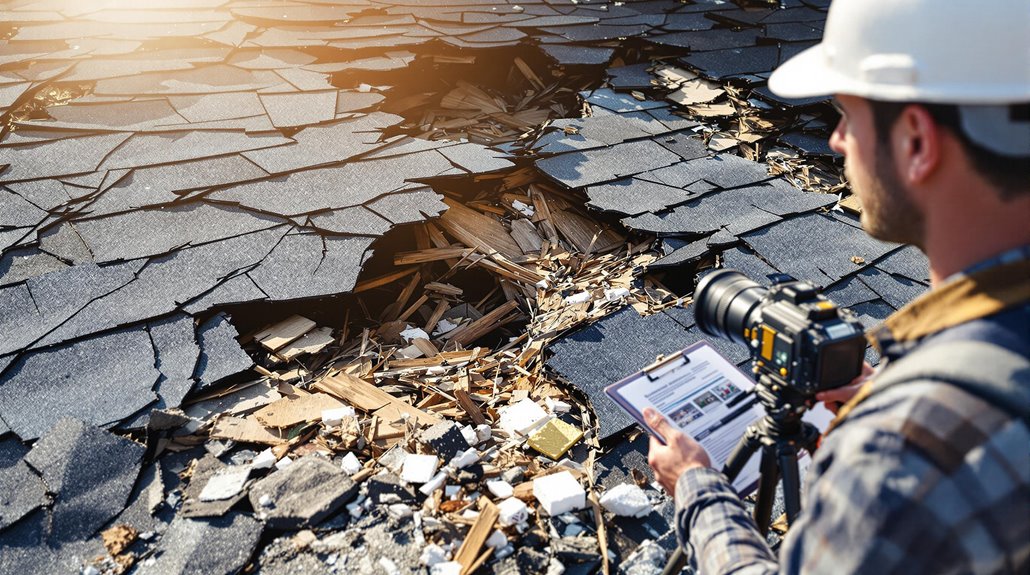
Thorough photographic documentation of roof damage serves as vital evidence when disputing denied insurance claims.
Professional inspection reports from qualified roofing contractors provide detailed assessments of damage extent and repair requirements.
These expert evaluations, combined with clear visual evidence, establish a strong foundation for challenging the insurance company's decision and validating the legitimacy of the claim.
Working with a public adjuster benefits policyholders by increasing claim settlements between 20-800% through objective damage assessments and comprehensive documentation.
Document Damage With Photos
Properly documenting roof damage through photographs serves as essential evidence when disputing insurance claims.
Effective photographic strategies include capturing wide-angle shots of the entire roof structure while also obtaining detailed close-ups of specific damage areas.
Professional damage documentation should encompass interior and exterior impacts, from water stains to structural complications.
- Capture complete views from multiple angles, including aerial shots if possible
- Document specific damage points with detailed close-up photographs
- Guarantee all photos include accurate timestamps and weather event records
- Maintain organized files with clear descriptions and systematic labeling
A thorough photographic record should include collateral damage to downspouts, vents, and surrounding areas.
This systematic approach provides insurance adjusters with clear evidence of the damage extent and supports the validity of the claim.
Working with public adjusters can increase settlement amounts by up to 800% through their expertise in documenting and presenting evidence.
Expert Inspection Reports Matter
Professional roof inspection reports serve as critical evidence when disputing insurance claim decisions, providing detailed documentation of damage assessment, material conditions, and causation factors.
Insurance-grade inspection criteria mandate exhaustive evaluations of both interior and exterior components, including attic spaces, drainage systems, and structural framework.
Effective report composition follows standardized formats, organizing findings into distinct categories while prioritizing urgent issues.
Independent inspectors must verify material quality, installation dates, and past repairs while documenting all observations with dated photographs. These unbiased assessments strengthen claim disputes by confirming damage causation and identifying issues not apparent to untrained observers. Insurance providers rely heavily on these detailed reports when evaluating property risk levels and determining appropriate claim resolutions.
Engaging a certified inspector within 72 hours of damage maximizes the accuracy and credibility of documentation for insurance claims.
Steps to File an Insurance Appeal
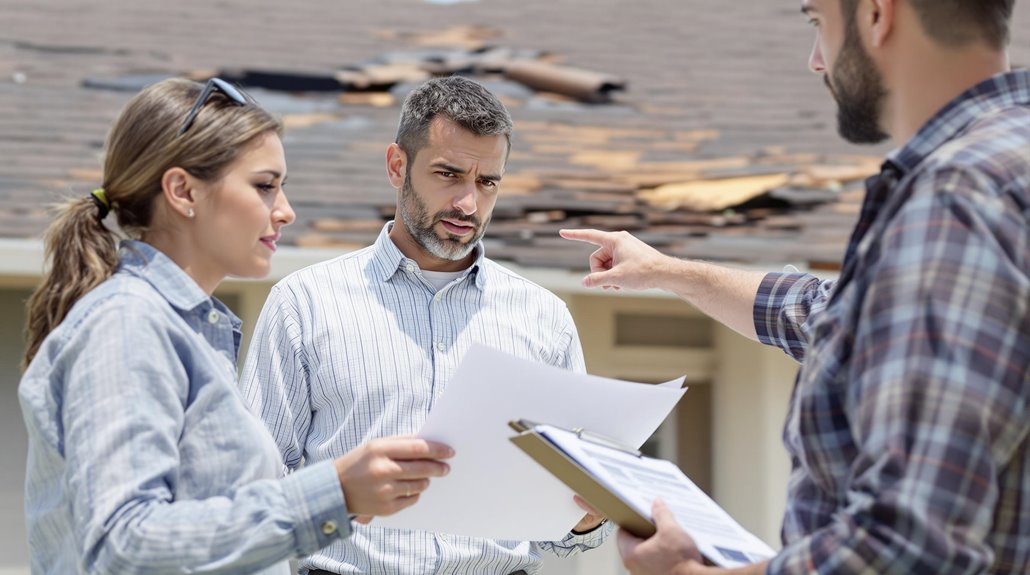
Filing an insurance appeal requires methodical attention to detail and adherence to specific procedural steps.
The Appeal Stages encompass document preparation, evidence collection, and formal submission, each following a strict Filing Timeline established by the insurance provider.
To successfully navigate the appeals process, policyholders should:
- Review the denial letter thoroughly and gather all supporting documentation
- Draft a detailed appeal letter addressing each denial reason with corresponding evidence
- Consult with professionals such as public adjusters or attorneys for guidance
- Submit the complete appeal package within designated deadlines
This systematic approach guarantees thorough documentation while maintaining compliance with procedural requirements.
If initial appeals prove unsuccessful, policyholders may need to escalate through additional channels, including mediation or legal action.
Claims involving a public adjuster typically result in settlements up to 800% higher than those handled without professional representation.
Working With Professional Roof Inspectors
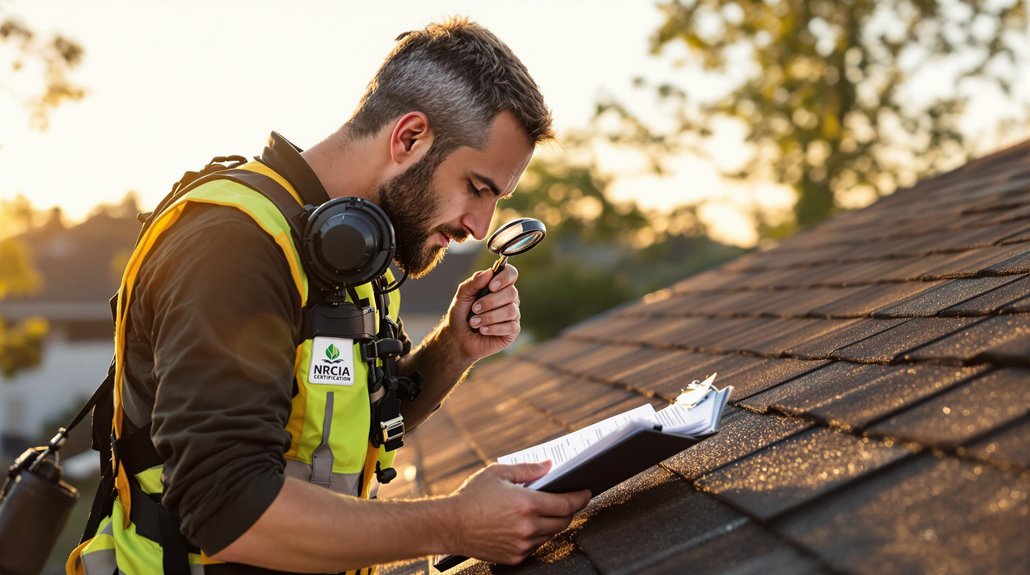
A thorough roof inspection conducted by qualified professionals forms the cornerstone of successful insurance claim disputes. Professional inspectors who meet rigorous inspection standards, particularly those certified by NRCIA, provide credible documentation that can effectively challenge claim denials.
These experts perform exhaustive evaluations of roofing systems, identifying both visible and concealed damage that may have been overlooked in initial assessments.
Certification verification is essential when selecting an inspector, as properly credentialed professionals possess specialized training in insurance-related evaluations. Their independent assessments yield detailed Forensic ROOF® inspection reports, which serve as authoritative evidence in disputed claims.
These reports meticulously document all damage findings, causation factors, and system-specific attributes, providing insurers with the technical documentation necessary to reevaluate denied claims. Working with public insurance adjusters can increase settlement amounts by 30-50% compared to filing independently.
Legal Options and External Reviews

When insurance companies deny legitimate roof claims, policyholders have several legal remedies and external review options available.
Understanding judicial precedents and legal timeframes is essential when pursuing these options. Insurance disputes can be resolved through various channels, from administrative appeals to litigation.
- File a formal appeal with the insurance company, providing additional documentation and evidence to support the claim
- Contact state insurance regulatory bodies to initiate an external review process
- Engage a public adjuster to professionally evaluate and negotiate the claim
- Pursue legal action within prescribed timeframes if other methods fail
The resolution process may involve mediation, administrative hearings, or court proceedings.
Policyholders should maintain detailed records of all communications and gather thorough documentation to support their position throughout the dispute process.
Studies show that claims handled by public adjusters result in settlements up to 800% higher compared to independently managed claims.
Financing Options for Roof Repairs

Beyond pursuing legal remedies, homeowners facing roof repair expenses have multiple financing alternatives to explore. Strategic budget planning can help determine the most cost-effective solution among personal loans, home equity options, and mortgage refinancing opportunities. Understanding each option's implications for long-term financial health is vital.
| Financing Type | Key Features | Interest Rate Range |
|---|---|---|
| Personal Loans | No collateral required, fixed payments | 7.5% – 36% APR |
| Home Equity | Uses home as collateral, longer terms | 3% – 8% APR |
| Gov't Programs | Lower credit requirements, specialized terms | 3.5% – 12% APR |
For homeowners with sufficient equity, cash-out mortgage refinancing often provides the lowest interest rates. Alternative solutions include roofing company financing plans and government-backed renovation loans, though careful evaluation of terms and fees remains essential.
Essential Documentation Practices

Proper documentation stands as the cornerstone of successfully disputing a denied roof insurance claim.
Effective document handling and record organization procedures substantially influence the outcome of an appeal.
Insurance providers require thorough evidence to reconsider their decision, making systematic documentation essential.
Key documentation requirements include:
- Clear, detailed photographs and videos showcasing the roof damage from multiple angles
- Professional inspection reports and contractor estimates detailing repair costs
- Chronological records of all communications with insurance representatives
- Maintenance history proving regular upkeep and proper care of the roof
A methodical approach to organizing and maintaining these records strengthens the dispute process.
When submitting documentation, claimants should verify all materials are properly dated, indexed, and accompanied by a concise summary of the claim's merits.
The Benefits Of Consulting A Public Adjuster
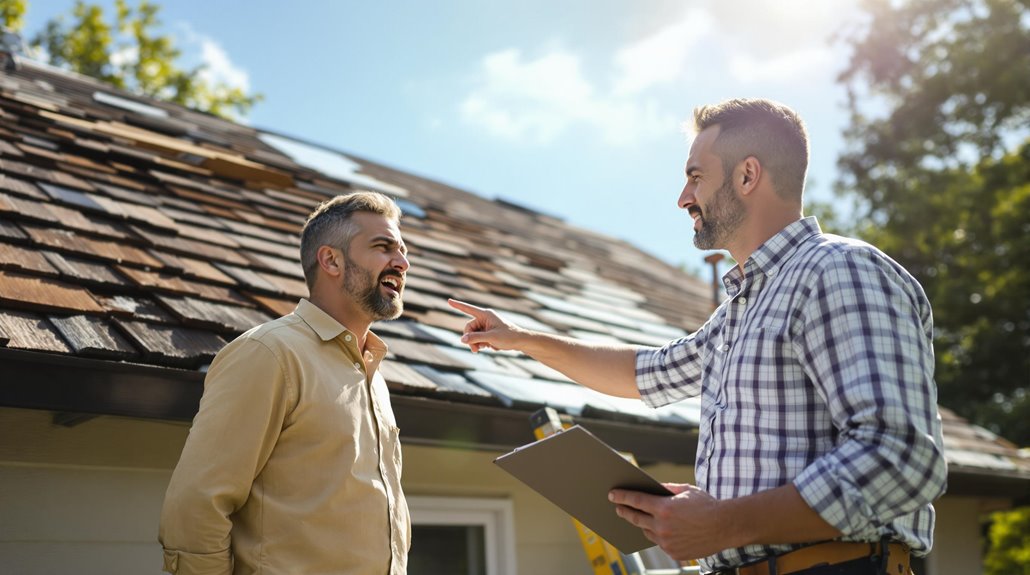
Public adjusters bring extensive expertise to insurance roof claim disputes through their specialized knowledge of claims processes and policy interpretation.
Their objective assessment methods and thorough documentation practices help identify all legitimate damages while streamlining the complex claims procedure.
Professional public adjusters typically secure higher settlements for policyholders through skilled negotiation tactics and complete understanding of insurance coverage terms.
Expertise In Insurance Claims
Professional expertise in insurance claims handling represents an essential advantage when managing complex roof claim disputes.
Public adjusters possess thorough claims expertise and insurance knowledge that substantially enhances the probability of successful claim resolution.
Key aspects of their professional competence include:
- Advanced policy interpretation skills to identify all applicable coverages and benefits
- Systematic damage evaluation methodology to document both visible and concealed issues
- Strategic negotiation capabilities to counter inadequate settlement offers
- Comprehensive documentation practices that strengthen claim validity
Their specialized training and licensure guarantee adherence to state regulations while representing policyholder interests. This expertise enables them to navigate complex claim procedures, maximize recovery potential, and secure fair compensation through established industry protocols and standards-compliant methods.
Objective Damage Assessment
When pursuing an insurance claim for roof damage, an objective damage assessment conducted by a qualified public adjuster serves as a critical foundation for successful claim resolution. This extensive damage verification process involves thorough inspection, documentation, and precise estimation of financial losses sustained by the property.
Public adjusters execute detailed loss evaluations by meticulously documenting every aspect of the damage, from visible structural issues to hidden complications that might affect long-term integrity.
Their expertise in assessment typically results in substantially higher settlement outcomes, often three to five times greater than claims handled without professional assistance. They provide impartial appraisals that strengthen the policyholder's position during negotiations with insurance companies, while ensuring all damage aspects are properly identified and valued according to policy coverage.
Streamlined Claim Process
Engaging a public adjuster substantially streamlines the insurance claim process by providing thorough expertise and systematic management of all documentation, communication, and negotiation aspects.
Their professional approach establishes an efficient workflow that optimizes claim resolution while reducing policyholder stress.
Key benefits of their streamlined approach include:
- Systematic organization and organized submission of all required documentation, including proof of loss and damage assessments
- Expert handling of all insurance company communications, eliminating policyholder burden
- Professional interpretation of policy terms and conditions to maximize claim potential
- Strategic negotiation management based on thorough understanding of insurance procedures and regulations
This systematic approach guarantees claims are handled efficiently while maintaining compliance with insurance requirements and local regulations, ultimately working toward achieving maximum settlement outcomes for policyholders.
Higher Claim Payouts & Settlements
Securing higher claim payouts and settlements stands as a primary advantage of utilizing public adjuster services for insurance claims. Through their expert property damage assessment capabilities and thorough documentation practices, public adjusters consistently demonstrate the ability to maximize settlement values. Payout statistics indicate that claims handled by public adjusters frequently result in substantially higher compensation compared to those filed independently by policyholders.
Their specialized training in identifying overlooked damages, combined with thorough property evaluations, guarantees all legitimate losses are included in the claim.
Settlement averages reflect the effectiveness of their negotiation strategies and deep understanding of insurance company tactics. Working on a contingency basis, public adjusters are inherently motivated to secure the highest possible settlements while providing risk-free representation for policyholders.
About The Public Claims Adjusters Network (PCAN)
Through its extensive network of licensed professionals, The Public Claims Adjusters Network (PCAN) operates as an independent advocacy organization that exclusively represents policyholders in insurance claim disputes.
With Network Operations spanning all 50 states and a Global Presence across five continents, PCAN delivers all-inclusive claims management services.
Key aspects of PCAN's service delivery include:
- Professional damage assessment and policy interpretation expertise
- Complete claim management from filing to settlement finalization
- Customized claim strategies with detailed loss calculations
- Direct insurance company negotiations on behalf of policyholders
PCAN operates on a contingency fee basis, collecting payment only after successful settlement.
Their expertise encompasses both residential and commercial claims, with specialists focusing on maximizing claim values through detailed documentation and strategic negotiation techniques.
Frequently Asked Questions
Can I Sue My Insurance Company for Bad Faith Denial?
Policyholders maintain legal standing to pursue litigation against insurers for bad faith denial, potentially recovering both compensatory and punitive damages when demonstrating unreasonable claim denials or unfair practices.
How Long Does a Typical Roof Claim Dispute Process Take?
While simple appeals may resolve in weeks, typical roof claim disputes stretch endlessly through a 3-12 month process timeline, potentially extending to 18+ months if litigation becomes necessary.
Will Filing Multiple Appeals Affect My Future Insurance Premiums?
Insurance regulations prohibit premium increases solely based on appeals. While claim history factors into premium calculations, exercising appeal rights does not directly impact future insurance rates under regulatory protections.
Can I Switch Insurance Companies During an Ongoing Roof Claim Dispute?
Why worry about timing? Policyholders can switch insurance companies during ongoing disputes, as coverage transfer occurs separately. The original insurer remains responsible for existing claims while new policies activate.
Does Homeowners Insurance Cover Temporary Repairs During the Appeal Process?
Homeowners insurance typically covers necessary temporary fixes, including emergency tarping, during appeals when documented properly. Coverage extends to reasonable measures taken to prevent additional damage while disputes are resolved.
References
- https://rescue-my-roof.com/blog/steps-after-homeowners-insurance-denies-roof-claim/
- https://www.opic.texas.gov/health-insurance/get-help/appeal-denied-claim/
- https://www.jurytrial.us/what-to-do-if-insurance-denied-roof-claim/
- https://carrigananderson.com/faqs/what-to-do-if-insurance-denied-my-roof-claim/
- https://content.naic.org/article/consumer-insight-health-insurance-claim-denied-how-appeal-denial
- https://www.allstate.com/resources/home-insurance/roof-leaks-cover-damage
- https://www.bankrate.com/insurance/homeowners-insurance/roof-insurance/
- https://www.progressive.com/answers/does-home-insurance-cover-roof-damage/
- https://www.restorationroofing.com/8-reasons-why-roof-claims-are-denied-by-insurance/
- https://abc7chicago.com/home-insurance-companies-claim-illinois-department-of-complaints/14036968/
